Australian Building and Construction: Legal and Regulatory Overview
VerifiedAdded on 2020/03/23
|9
|2032
|55
Report
AI Summary
This report provides a comprehensive overview of the legal and regulatory framework governing the building and construction industry in Victoria, Australia. It begins by outlining the Australian legal system, including its sources of law such as the Constitution, legislation, regulations, and common law. The report then delves into the professional codes of practice and relevant standards within the construction industry. A significant portion of the report focuses on the system of codes, regulations, standards, and legislation applicable in Victoria, with specific attention given to the Building Act 1975, the Building Code of Australia (BCA), the Building and Construction Industry Payments Act (BCIPA), and the Fair Work Act. The report also touches upon the National Employment Standards (NES). The report aims to provide a clear understanding of the legal requirements for those involved in the building and construction sector in Victoria, offering valuable insights into compliance and industry best practices.
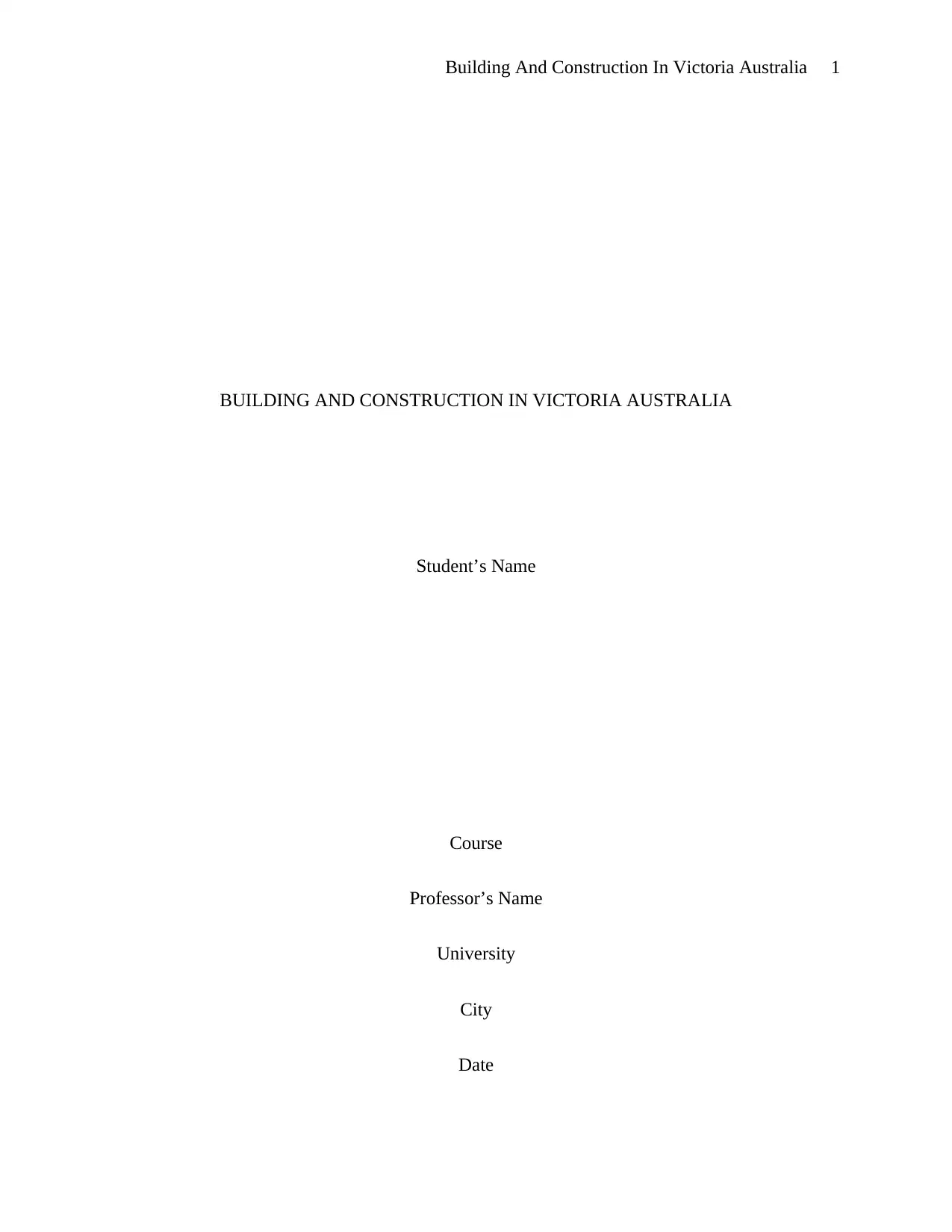
Building And Construction In Victoria Australia 1
BUILDING AND CONSTRUCTION IN VICTORIA AUSTRALIA
Student’s Name
Course
Professor’s Name
University
City
Date
BUILDING AND CONSTRUCTION IN VICTORIA AUSTRALIA
Student’s Name
Course
Professor’s Name
University
City
Date
Paraphrase This Document
Need a fresh take? Get an instant paraphrase of this document with our AI Paraphraser
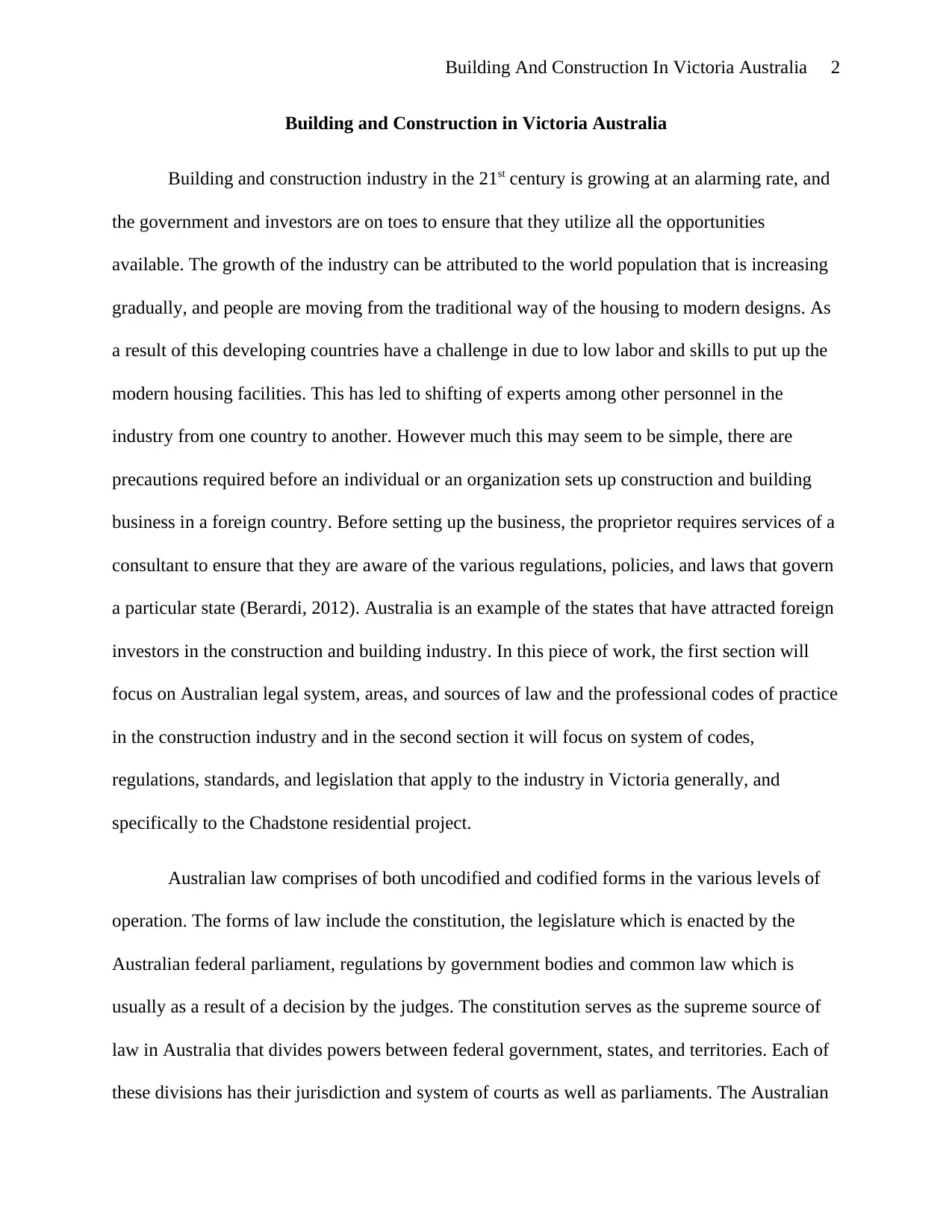
Building And Construction In Victoria Australia 2
Building and Construction in Victoria Australia
Building and construction industry in the 21st century is growing at an alarming rate, and
the government and investors are on toes to ensure that they utilize all the opportunities
available. The growth of the industry can be attributed to the world population that is increasing
gradually, and people are moving from the traditional way of the housing to modern designs. As
a result of this developing countries have a challenge in due to low labor and skills to put up the
modern housing facilities. This has led to shifting of experts among other personnel in the
industry from one country to another. However much this may seem to be simple, there are
precautions required before an individual or an organization sets up construction and building
business in a foreign country. Before setting up the business, the proprietor requires services of a
consultant to ensure that they are aware of the various regulations, policies, and laws that govern
a particular state (Berardi, 2012). Australia is an example of the states that have attracted foreign
investors in the construction and building industry. In this piece of work, the first section will
focus on Australian legal system, areas, and sources of law and the professional codes of practice
in the construction industry and in the second section it will focus on system of codes,
regulations, standards, and legislation that apply to the industry in Victoria generally, and
specifically to the Chadstone residential project.
Australian law comprises of both uncodified and codified forms in the various levels of
operation. The forms of law include the constitution, the legislature which is enacted by the
Australian federal parliament, regulations by government bodies and common law which is
usually as a result of a decision by the judges. The constitution serves as the supreme source of
law in Australia that divides powers between federal government, states, and territories. Each of
these divisions has their jurisdiction and system of courts as well as parliaments. The Australian
Building and Construction in Victoria Australia
Building and construction industry in the 21st century is growing at an alarming rate, and
the government and investors are on toes to ensure that they utilize all the opportunities
available. The growth of the industry can be attributed to the world population that is increasing
gradually, and people are moving from the traditional way of the housing to modern designs. As
a result of this developing countries have a challenge in due to low labor and skills to put up the
modern housing facilities. This has led to shifting of experts among other personnel in the
industry from one country to another. However much this may seem to be simple, there are
precautions required before an individual or an organization sets up construction and building
business in a foreign country. Before setting up the business, the proprietor requires services of a
consultant to ensure that they are aware of the various regulations, policies, and laws that govern
a particular state (Berardi, 2012). Australia is an example of the states that have attracted foreign
investors in the construction and building industry. In this piece of work, the first section will
focus on Australian legal system, areas, and sources of law and the professional codes of practice
in the construction industry and in the second section it will focus on system of codes,
regulations, standards, and legislation that apply to the industry in Victoria generally, and
specifically to the Chadstone residential project.
Australian law comprises of both uncodified and codified forms in the various levels of
operation. The forms of law include the constitution, the legislature which is enacted by the
Australian federal parliament, regulations by government bodies and common law which is
usually as a result of a decision by the judges. The constitution serves as the supreme source of
law in Australia that divides powers between federal government, states, and territories. Each of
these divisions has their jurisdiction and system of courts as well as parliaments. The Australian
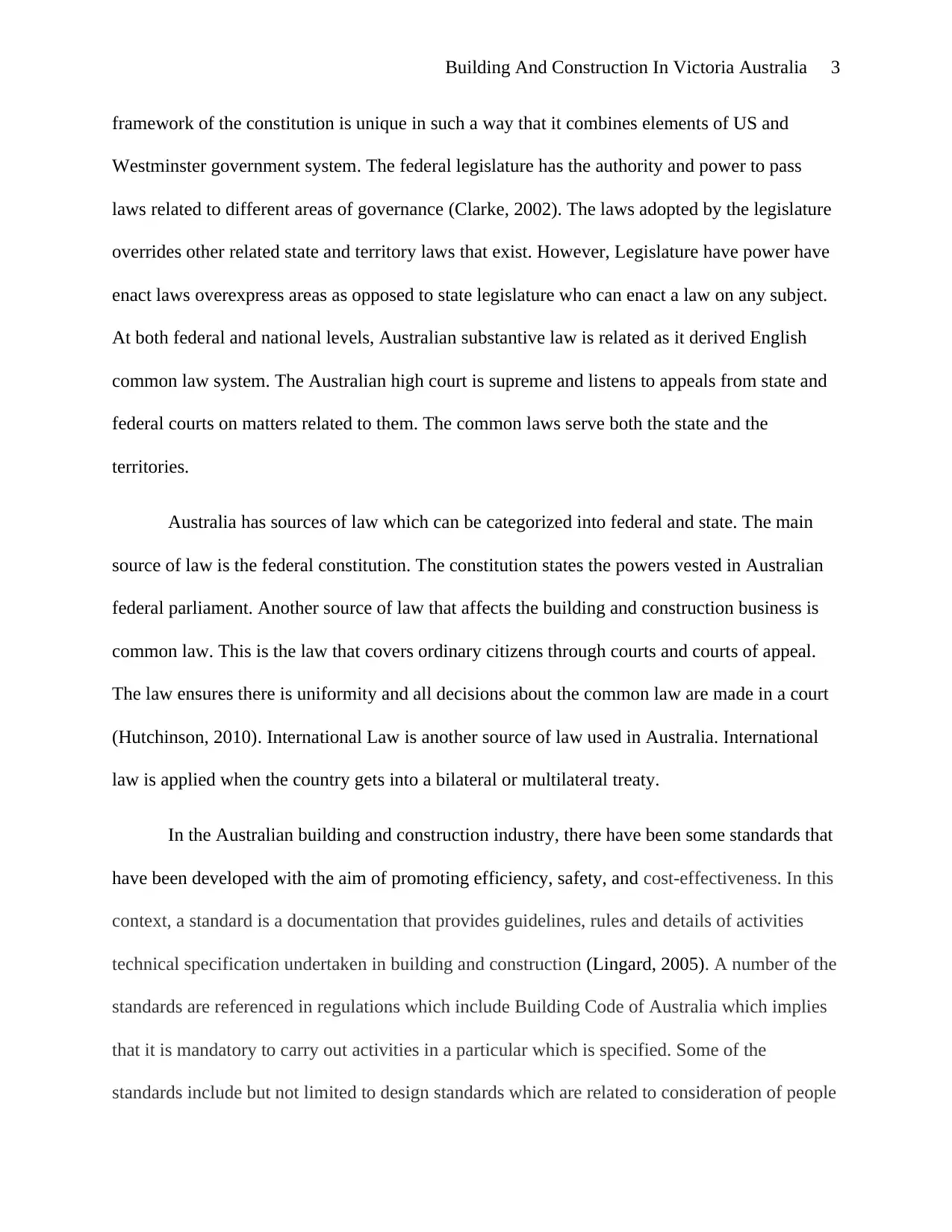
Building And Construction In Victoria Australia 3
framework of the constitution is unique in such a way that it combines elements of US and
Westminster government system. The federal legislature has the authority and power to pass
laws related to different areas of governance (Clarke, 2002). The laws adopted by the legislature
overrides other related state and territory laws that exist. However, Legislature have power have
enact laws overexpress areas as opposed to state legislature who can enact a law on any subject.
At both federal and national levels, Australian substantive law is related as it derived English
common law system. The Australian high court is supreme and listens to appeals from state and
federal courts on matters related to them. The common laws serve both the state and the
territories.
Australia has sources of law which can be categorized into federal and state. The main
source of law is the federal constitution. The constitution states the powers vested in Australian
federal parliament. Another source of law that affects the building and construction business is
common law. This is the law that covers ordinary citizens through courts and courts of appeal.
The law ensures there is uniformity and all decisions about the common law are made in a court
(Hutchinson, 2010). International Law is another source of law used in Australia. International
law is applied when the country gets into a bilateral or multilateral treaty.
In the Australian building and construction industry, there have been some standards that
have been developed with the aim of promoting efficiency, safety, and cost-effectiveness. In this
context, a standard is a documentation that provides guidelines, rules and details of activities
technical specification undertaken in building and construction (Lingard, 2005). A number of the
standards are referenced in regulations which include Building Code of Australia which implies
that it is mandatory to carry out activities in a particular which is specified. Some of the
standards include but not limited to design standards which are related to consideration of people
framework of the constitution is unique in such a way that it combines elements of US and
Westminster government system. The federal legislature has the authority and power to pass
laws related to different areas of governance (Clarke, 2002). The laws adopted by the legislature
overrides other related state and territory laws that exist. However, Legislature have power have
enact laws overexpress areas as opposed to state legislature who can enact a law on any subject.
At both federal and national levels, Australian substantive law is related as it derived English
common law system. The Australian high court is supreme and listens to appeals from state and
federal courts on matters related to them. The common laws serve both the state and the
territories.
Australia has sources of law which can be categorized into federal and state. The main
source of law is the federal constitution. The constitution states the powers vested in Australian
federal parliament. Another source of law that affects the building and construction business is
common law. This is the law that covers ordinary citizens through courts and courts of appeal.
The law ensures there is uniformity and all decisions about the common law are made in a court
(Hutchinson, 2010). International Law is another source of law used in Australia. International
law is applied when the country gets into a bilateral or multilateral treaty.
In the Australian building and construction industry, there have been some standards that
have been developed with the aim of promoting efficiency, safety, and cost-effectiveness. In this
context, a standard is a documentation that provides guidelines, rules and details of activities
technical specification undertaken in building and construction (Lingard, 2005). A number of the
standards are referenced in regulations which include Building Code of Australia which implies
that it is mandatory to carry out activities in a particular which is specified. Some of the
standards include but not limited to design standards which are related to consideration of people
⊘ This is a preview!⊘
Do you want full access?
Subscribe today to unlock all pages.

Trusted by 1+ million students worldwide
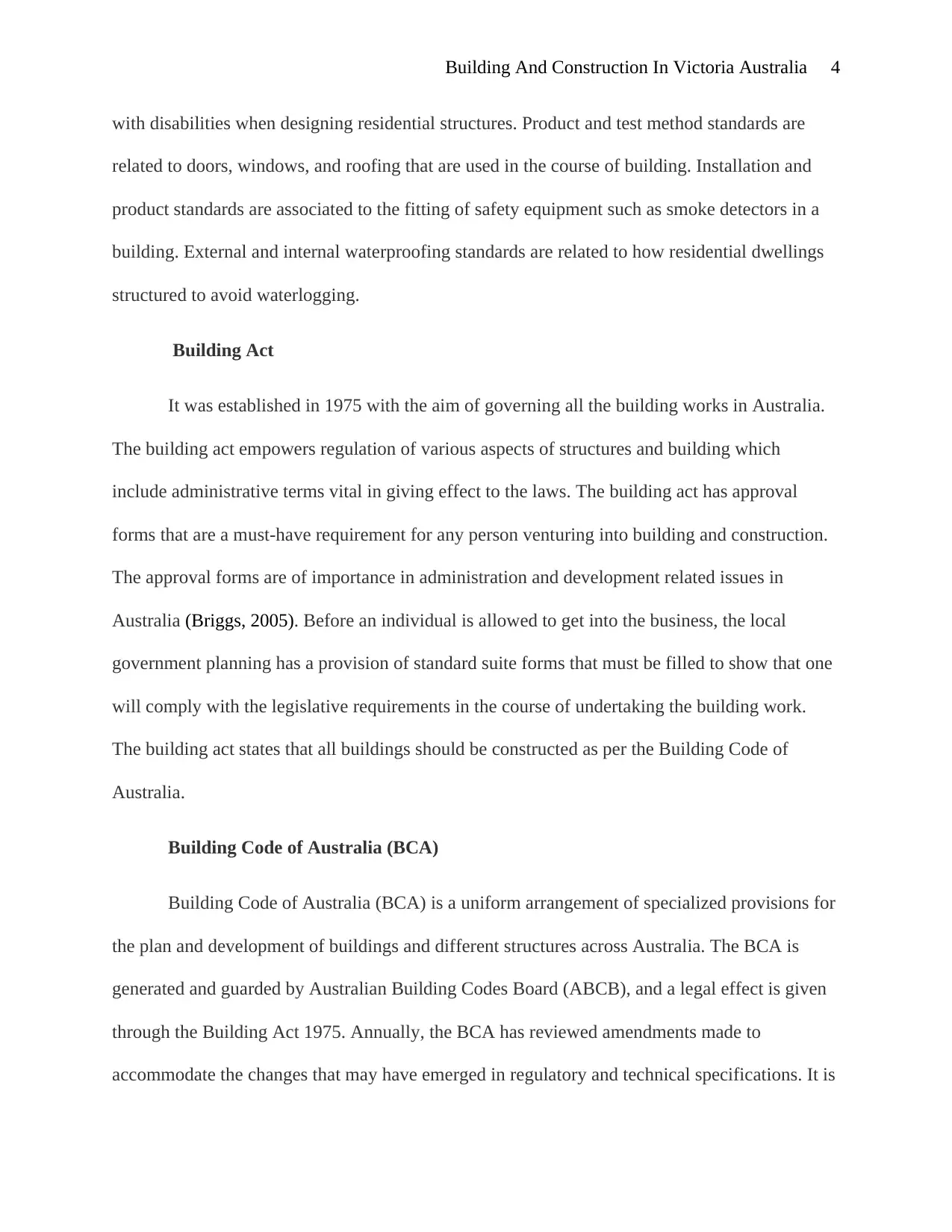
Building And Construction In Victoria Australia 4
with disabilities when designing residential structures. Product and test method standards are
related to doors, windows, and roofing that are used in the course of building. Installation and
product standards are associated to the fitting of safety equipment such as smoke detectors in a
building. External and internal waterproofing standards are related to how residential dwellings
structured to avoid waterlogging.
Building Act
It was established in 1975 with the aim of governing all the building works in Australia.
The building act empowers regulation of various aspects of structures and building which
include administrative terms vital in giving effect to the laws. The building act has approval
forms that are a must-have requirement for any person venturing into building and construction.
The approval forms are of importance in administration and development related issues in
Australia (Briggs, 2005). Before an individual is allowed to get into the business, the local
government planning has a provision of standard suite forms that must be filled to show that one
will comply with the legislative requirements in the course of undertaking the building work.
The building act states that all buildings should be constructed as per the Building Code of
Australia.
Building Code of Australia (BCA)
Building Code of Australia (BCA) is a uniform arrangement of specialized provisions for
the plan and development of buildings and different structures across Australia. The BCA is
generated and guarded by Australian Building Codes Board (ABCB), and a legal effect is given
through the Building Act 1975. Annually, the BCA has reviewed amendments made to
accommodate the changes that may have emerged in regulatory and technical specifications. It is
with disabilities when designing residential structures. Product and test method standards are
related to doors, windows, and roofing that are used in the course of building. Installation and
product standards are associated to the fitting of safety equipment such as smoke detectors in a
building. External and internal waterproofing standards are related to how residential dwellings
structured to avoid waterlogging.
Building Act
It was established in 1975 with the aim of governing all the building works in Australia.
The building act empowers regulation of various aspects of structures and building which
include administrative terms vital in giving effect to the laws. The building act has approval
forms that are a must-have requirement for any person venturing into building and construction.
The approval forms are of importance in administration and development related issues in
Australia (Briggs, 2005). Before an individual is allowed to get into the business, the local
government planning has a provision of standard suite forms that must be filled to show that one
will comply with the legislative requirements in the course of undertaking the building work.
The building act states that all buildings should be constructed as per the Building Code of
Australia.
Building Code of Australia (BCA)
Building Code of Australia (BCA) is a uniform arrangement of specialized provisions for
the plan and development of buildings and different structures across Australia. The BCA is
generated and guarded by Australian Building Codes Board (ABCB), and a legal effect is given
through the Building Act 1975. Annually, the BCA has reviewed amendments made to
accommodate the changes that may have emerged in regulatory and technical specifications. It is
Paraphrase This Document
Need a fresh take? Get an instant paraphrase of this document with our AI Paraphraser
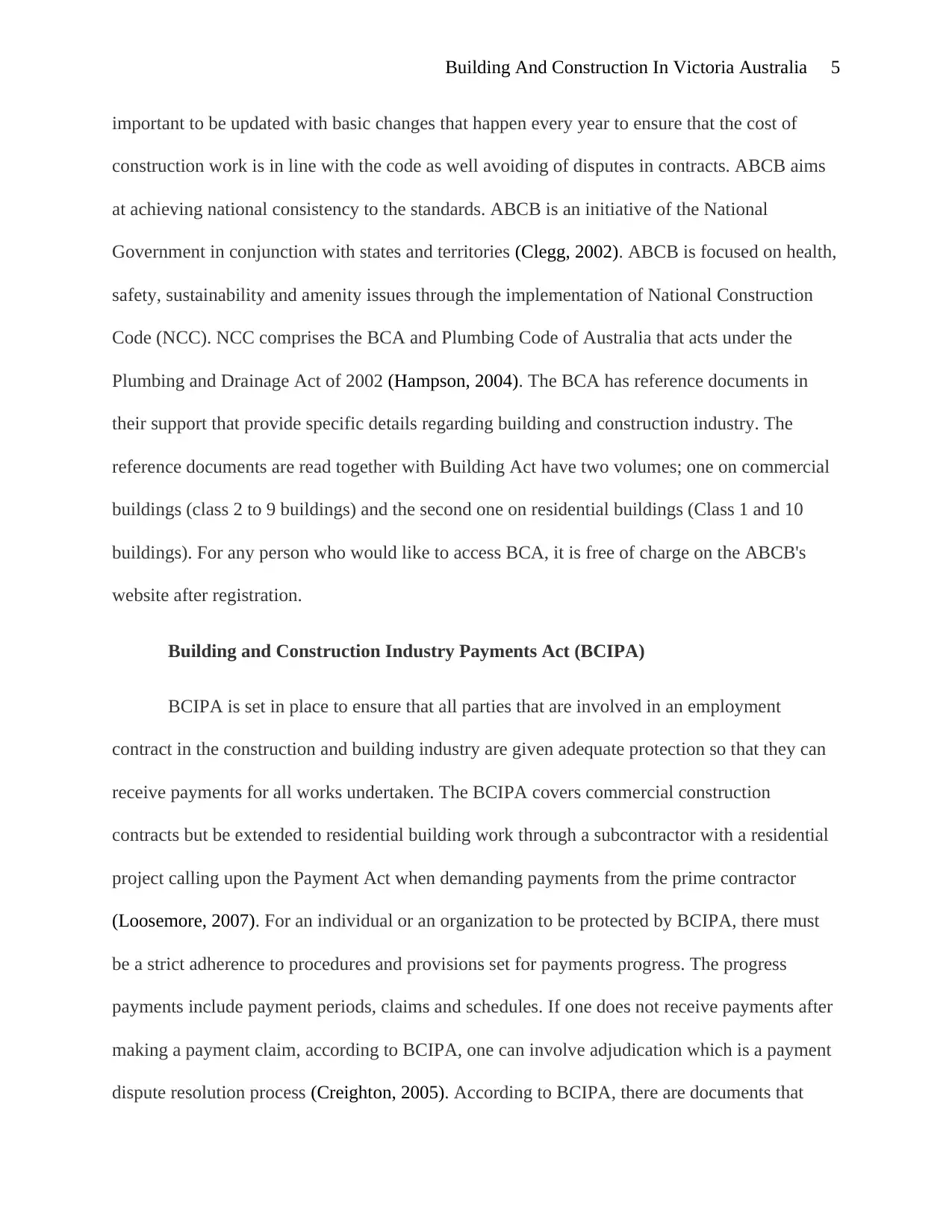
Building And Construction In Victoria Australia 5
important to be updated with basic changes that happen every year to ensure that the cost of
construction work is in line with the code as well avoiding of disputes in contracts. ABCB aims
at achieving national consistency to the standards. ABCB is an initiative of the National
Government in conjunction with states and territories (Clegg, 2002). ABCB is focused on health,
safety, sustainability and amenity issues through the implementation of National Construction
Code (NCC). NCC comprises the BCA and Plumbing Code of Australia that acts under the
Plumbing and Drainage Act of 2002 (Hampson, 2004). The BCA has reference documents in
their support that provide specific details regarding building and construction industry. The
reference documents are read together with Building Act have two volumes; one on commercial
buildings (class 2 to 9 buildings) and the second one on residential buildings (Class 1 and 10
buildings). For any person who would like to access BCA, it is free of charge on the ABCB's
website after registration.
Building and Construction Industry Payments Act (BCIPA)
BCIPA is set in place to ensure that all parties that are involved in an employment
contract in the construction and building industry are given adequate protection so that they can
receive payments for all works undertaken. The BCIPA covers commercial construction
contracts but be extended to residential building work through a subcontractor with a residential
project calling upon the Payment Act when demanding payments from the prime contractor
(Loosemore, 2007). For an individual or an organization to be protected by BCIPA, there must
be a strict adherence to procedures and provisions set for payments progress. The progress
payments include payment periods, claims and schedules. If one does not receive payments after
making a payment claim, according to BCIPA, one can involve adjudication which is a payment
dispute resolution process (Creighton, 2005). According to BCIPA, there are documents that
important to be updated with basic changes that happen every year to ensure that the cost of
construction work is in line with the code as well avoiding of disputes in contracts. ABCB aims
at achieving national consistency to the standards. ABCB is an initiative of the National
Government in conjunction with states and territories (Clegg, 2002). ABCB is focused on health,
safety, sustainability and amenity issues through the implementation of National Construction
Code (NCC). NCC comprises the BCA and Plumbing Code of Australia that acts under the
Plumbing and Drainage Act of 2002 (Hampson, 2004). The BCA has reference documents in
their support that provide specific details regarding building and construction industry. The
reference documents are read together with Building Act have two volumes; one on commercial
buildings (class 2 to 9 buildings) and the second one on residential buildings (Class 1 and 10
buildings). For any person who would like to access BCA, it is free of charge on the ABCB's
website after registration.
Building and Construction Industry Payments Act (BCIPA)
BCIPA is set in place to ensure that all parties that are involved in an employment
contract in the construction and building industry are given adequate protection so that they can
receive payments for all works undertaken. The BCIPA covers commercial construction
contracts but be extended to residential building work through a subcontractor with a residential
project calling upon the Payment Act when demanding payments from the prime contractor
(Loosemore, 2007). For an individual or an organization to be protected by BCIPA, there must
be a strict adherence to procedures and provisions set for payments progress. The progress
payments include payment periods, claims and schedules. If one does not receive payments after
making a payment claim, according to BCIPA, one can involve adjudication which is a payment
dispute resolution process (Creighton, 2005). According to BCIPA, there are documents that
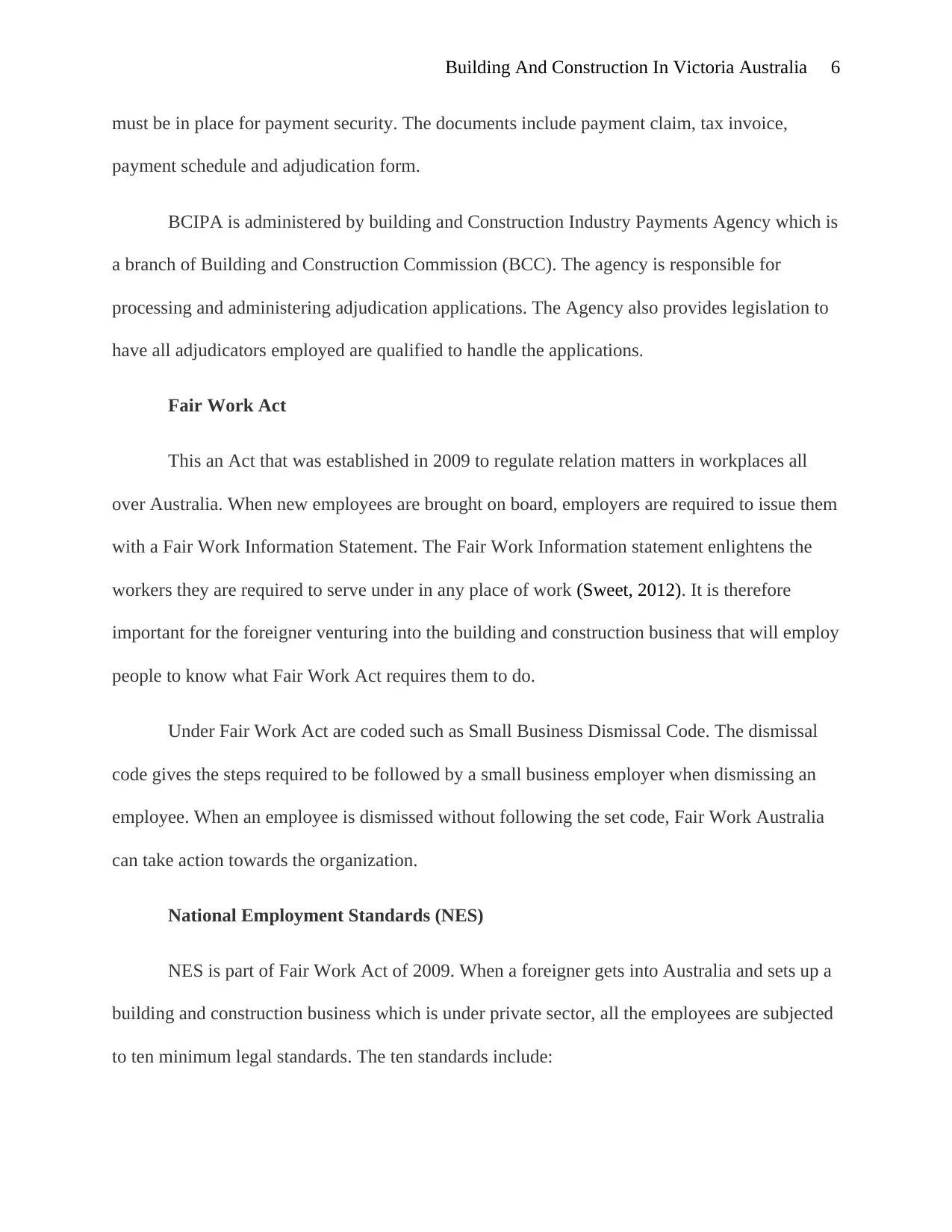
Building And Construction In Victoria Australia 6
must be in place for payment security. The documents include payment claim, tax invoice,
payment schedule and adjudication form.
BCIPA is administered by building and Construction Industry Payments Agency which is
a branch of Building and Construction Commission (BCC). The agency is responsible for
processing and administering adjudication applications. The Agency also provides legislation to
have all adjudicators employed are qualified to handle the applications.
Fair Work Act
This an Act that was established in 2009 to regulate relation matters in workplaces all
over Australia. When new employees are brought on board, employers are required to issue them
with a Fair Work Information Statement. The Fair Work Information statement enlightens the
workers they are required to serve under in any place of work (Sweet, 2012). It is therefore
important for the foreigner venturing into the building and construction business that will employ
people to know what Fair Work Act requires them to do.
Under Fair Work Act are coded such as Small Business Dismissal Code. The dismissal
code gives the steps required to be followed by a small business employer when dismissing an
employee. When an employee is dismissed without following the set code, Fair Work Australia
can take action towards the organization.
National Employment Standards (NES)
NES is part of Fair Work Act of 2009. When a foreigner gets into Australia and sets up a
building and construction business which is under private sector, all the employees are subjected
to ten minimum legal standards. The ten standards include:
must be in place for payment security. The documents include payment claim, tax invoice,
payment schedule and adjudication form.
BCIPA is administered by building and Construction Industry Payments Agency which is
a branch of Building and Construction Commission (BCC). The agency is responsible for
processing and administering adjudication applications. The Agency also provides legislation to
have all adjudicators employed are qualified to handle the applications.
Fair Work Act
This an Act that was established in 2009 to regulate relation matters in workplaces all
over Australia. When new employees are brought on board, employers are required to issue them
with a Fair Work Information Statement. The Fair Work Information statement enlightens the
workers they are required to serve under in any place of work (Sweet, 2012). It is therefore
important for the foreigner venturing into the building and construction business that will employ
people to know what Fair Work Act requires them to do.
Under Fair Work Act are coded such as Small Business Dismissal Code. The dismissal
code gives the steps required to be followed by a small business employer when dismissing an
employee. When an employee is dismissed without following the set code, Fair Work Australia
can take action towards the organization.
National Employment Standards (NES)
NES is part of Fair Work Act of 2009. When a foreigner gets into Australia and sets up a
building and construction business which is under private sector, all the employees are subjected
to ten minimum legal standards. The ten standards include:
⊘ This is a preview!⊘
Do you want full access?
Subscribe today to unlock all pages.

Trusted by 1+ million students worldwide
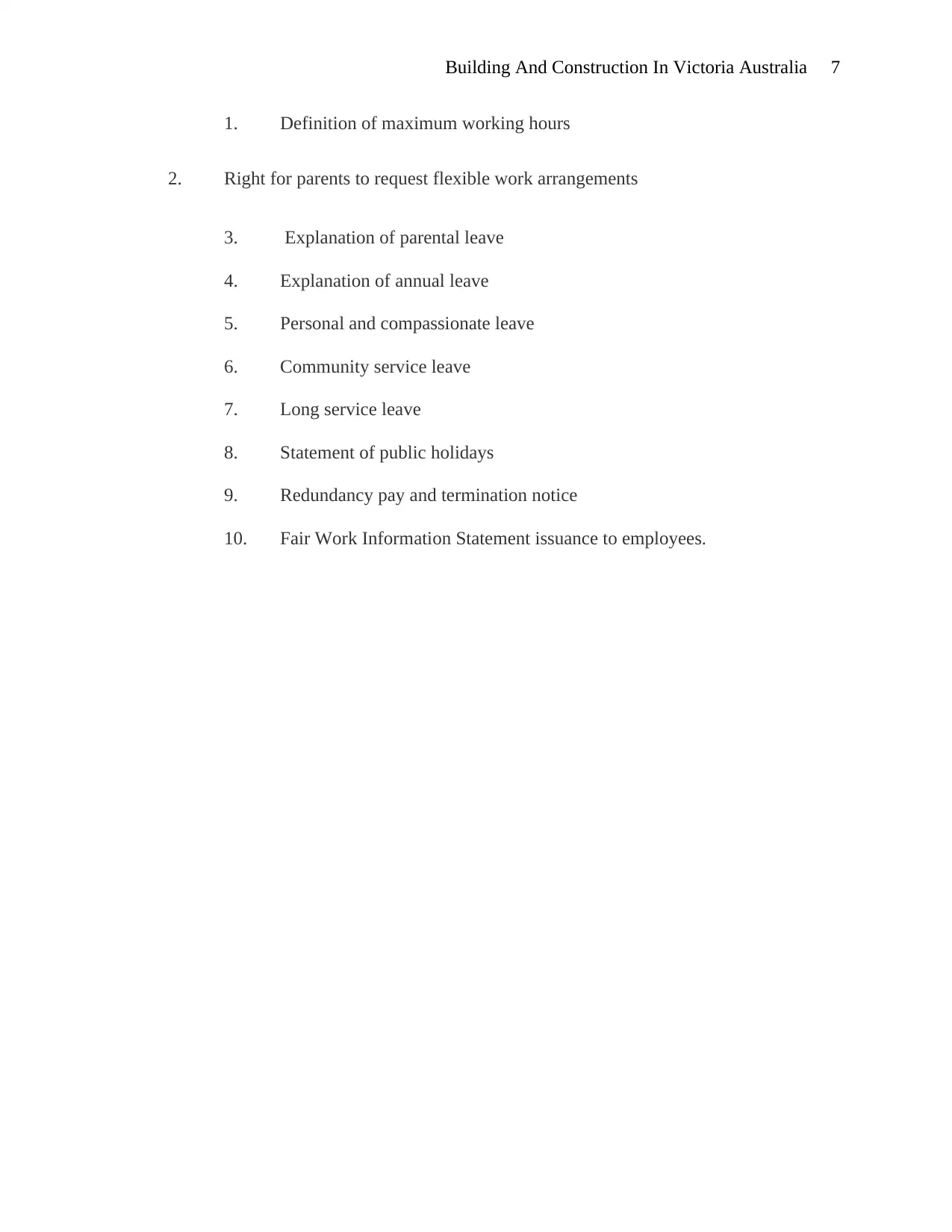
Building And Construction In Victoria Australia 7
1. Definition of maximum working hours
2. Right for parents to request flexible work arrangements
3. Explanation of parental leave
4. Explanation of annual leave
5. Personal and compassionate leave
6. Community service leave
7. Long service leave
8. Statement of public holidays
9. Redundancy pay and termination notice
10. Fair Work Information Statement issuance to employees.
1. Definition of maximum working hours
2. Right for parents to request flexible work arrangements
3. Explanation of parental leave
4. Explanation of annual leave
5. Personal and compassionate leave
6. Community service leave
7. Long service leave
8. Statement of public holidays
9. Redundancy pay and termination notice
10. Fair Work Information Statement issuance to employees.
Paraphrase This Document
Need a fresh take? Get an instant paraphrase of this document with our AI Paraphraser
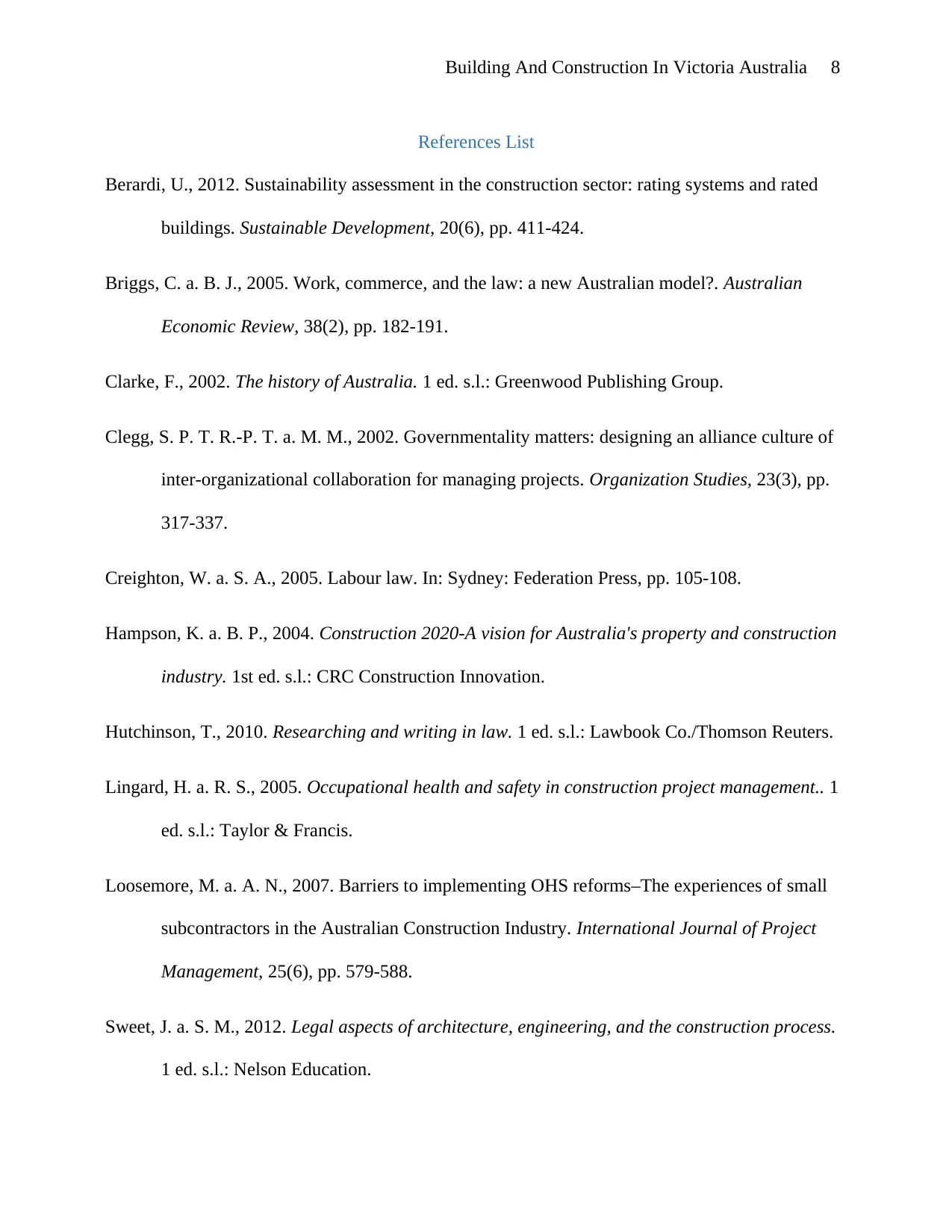
Building And Construction In Victoria Australia 8
References List
Berardi, U., 2012. Sustainability assessment in the construction sector: rating systems and rated
buildings. Sustainable Development, 20(6), pp. 411-424.
Briggs, C. a. B. J., 2005. Work, commerce, and the law: a new Australian model?. Australian
Economic Review, 38(2), pp. 182-191.
Clarke, F., 2002. The history of Australia. 1 ed. s.l.: Greenwood Publishing Group.
Clegg, S. P. T. R.-P. T. a. M. M., 2002. Governmentality matters: designing an alliance culture of
inter-organizational collaboration for managing projects. Organization Studies, 23(3), pp.
317-337.
Creighton, W. a. S. A., 2005. Labour law. In: Sydney: Federation Press, pp. 105-108.
Hampson, K. a. B. P., 2004. Construction 2020-A vision for Australia's property and construction
industry. 1st ed. s.l.: CRC Construction Innovation.
Hutchinson, T., 2010. Researching and writing in law. 1 ed. s.l.: Lawbook Co./Thomson Reuters.
Lingard, H. a. R. S., 2005. Occupational health and safety in construction project management.. 1
ed. s.l.: Taylor & Francis.
Loosemore, M. a. A. N., 2007. Barriers to implementing OHS reforms–The experiences of small
subcontractors in the Australian Construction Industry. International Journal of Project
Management, 25(6), pp. 579-588.
Sweet, J. a. S. M., 2012. Legal aspects of architecture, engineering, and the construction process.
1 ed. s.l.: Nelson Education.
References List
Berardi, U., 2012. Sustainability assessment in the construction sector: rating systems and rated
buildings. Sustainable Development, 20(6), pp. 411-424.
Briggs, C. a. B. J., 2005. Work, commerce, and the law: a new Australian model?. Australian
Economic Review, 38(2), pp. 182-191.
Clarke, F., 2002. The history of Australia. 1 ed. s.l.: Greenwood Publishing Group.
Clegg, S. P. T. R.-P. T. a. M. M., 2002. Governmentality matters: designing an alliance culture of
inter-organizational collaboration for managing projects. Organization Studies, 23(3), pp.
317-337.
Creighton, W. a. S. A., 2005. Labour law. In: Sydney: Federation Press, pp. 105-108.
Hampson, K. a. B. P., 2004. Construction 2020-A vision for Australia's property and construction
industry. 1st ed. s.l.: CRC Construction Innovation.
Hutchinson, T., 2010. Researching and writing in law. 1 ed. s.l.: Lawbook Co./Thomson Reuters.
Lingard, H. a. R. S., 2005. Occupational health and safety in construction project management.. 1
ed. s.l.: Taylor & Francis.
Loosemore, M. a. A. N., 2007. Barriers to implementing OHS reforms–The experiences of small
subcontractors in the Australian Construction Industry. International Journal of Project
Management, 25(6), pp. 579-588.
Sweet, J. a. S. M., 2012. Legal aspects of architecture, engineering, and the construction process.
1 ed. s.l.: Nelson Education.
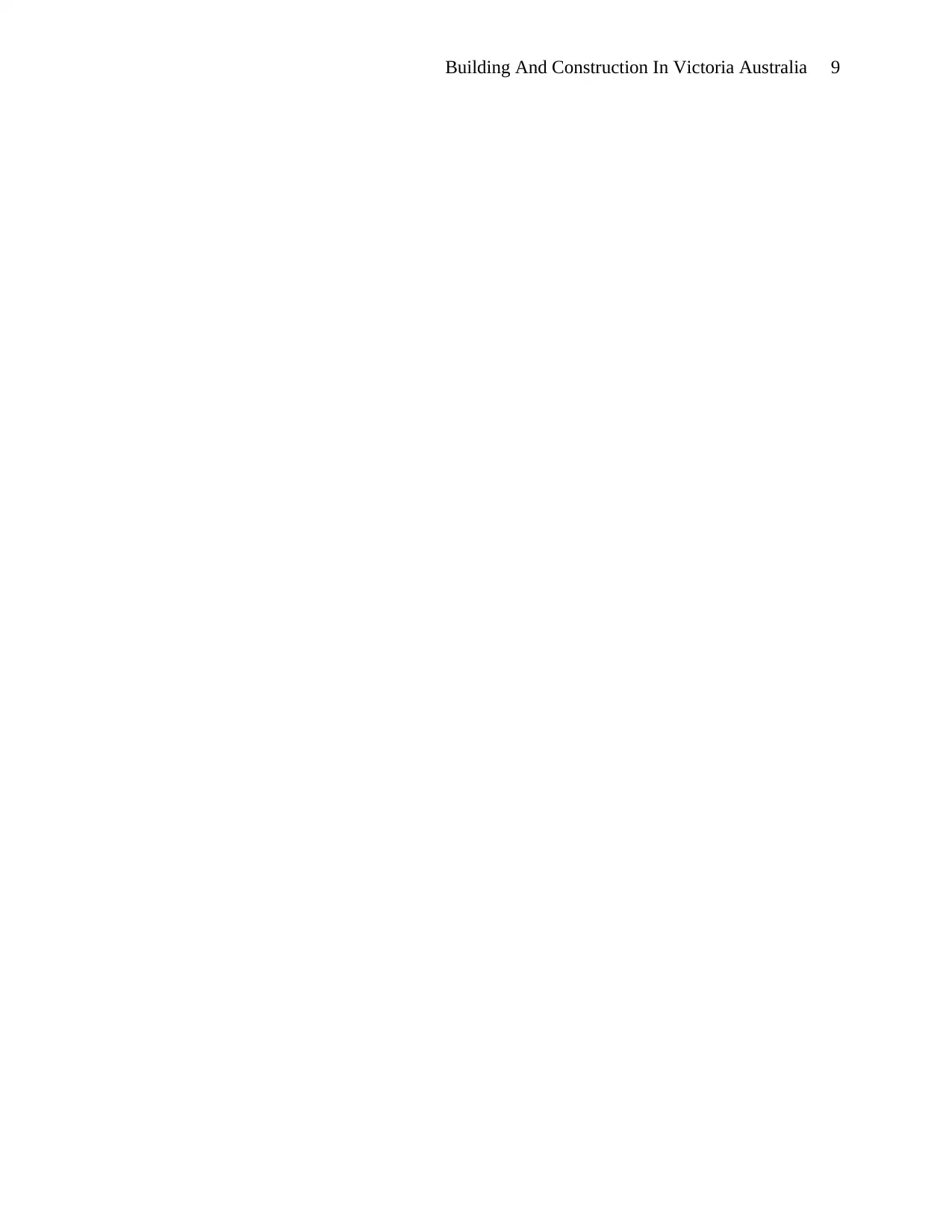
Building And Construction In Victoria Australia 9
⊘ This is a preview!⊘
Do you want full access?
Subscribe today to unlock all pages.

Trusted by 1+ million students worldwide
1 out of 9
Related Documents
Your All-in-One AI-Powered Toolkit for Academic Success.
+13062052269
info@desklib.com
Available 24*7 on WhatsApp / Email
![[object Object]](/_next/static/media/star-bottom.7253800d.svg)
Unlock your academic potential
Copyright © 2020–2025 A2Z Services. All Rights Reserved. Developed and managed by ZUCOL.





